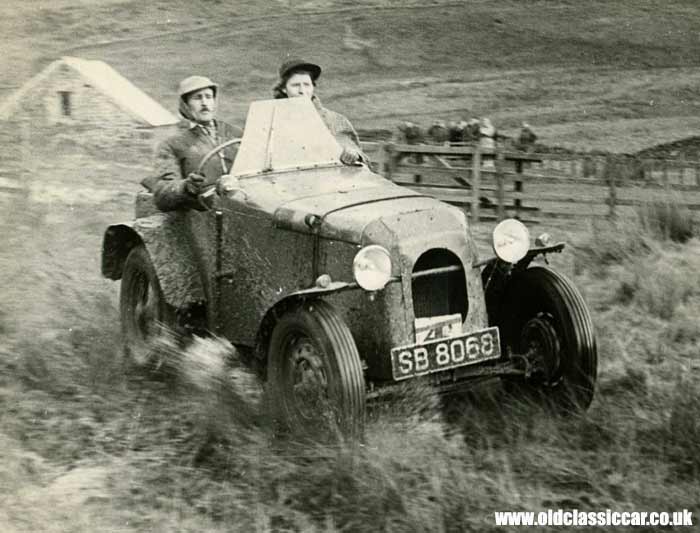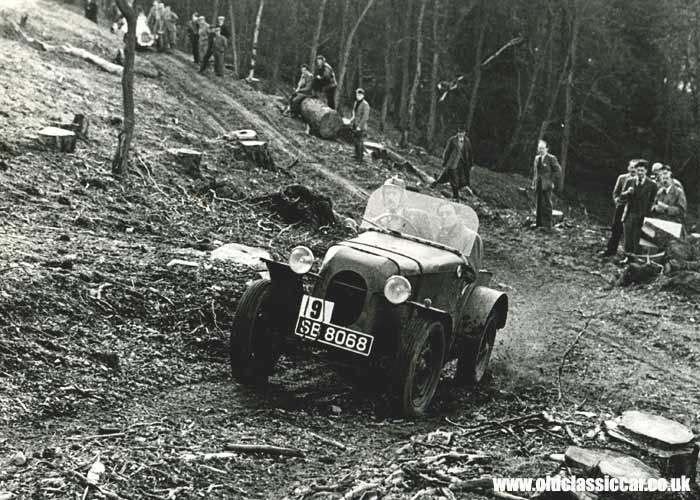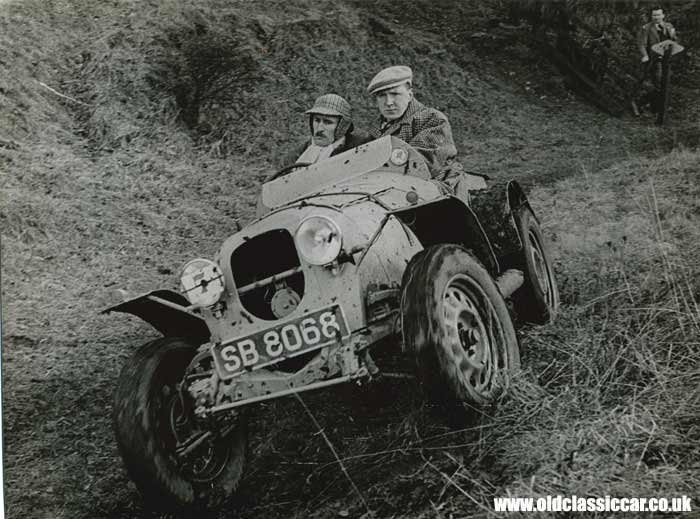Trialling in the post-war years.
On this page are four photographs showing the evolution of a home-built car, built with off-road trials
events in mind. This form of motorsport, which enjoyed a great deal of popularity after the war, and is still popular in vintage and club circles today, enabled Joe Bloggs to compete in a branch of competition where ingenuity, and driving ability, could score over a hefty budget. The variety of cars that compete in modern-day VSCC trials events is evidence of this, with later cars taking part in similar off-road events organised by local motor clubs up and down the country.
The idea of trialling is to tackle a series of fiendish climbs, often up tricky courses on the side of muddy hillsides, the objective being to clear the course and score maximum points. Points are also awarded to cars that run out of steam and traction part way up the course, depending on which of the marker flags the driver and co-driver (or 'bouncer') make it to. Trialling is often confused with hillclimbing, but the latter is a timed speed event over a measured distance. Trialling is all about reaching the top of the course, battling against the elements, rather than the stopwatch.
At first glance, I thought these photographs showed an identical car, at different locations. A closer look though confirms that many changes were made to this off-road machine between 1949 and 1951, no doubt in the owner's garage back at home, working late into the night with just a packet of Woodbines and a set of Whitworth spanners for company.
1. Start of the Moorfoot Trial 1949.
According to a pencil note on the back of the photograph, this gathering was at the start of the Moorfoot Trial, on the Peebles to Innerleithen Road. Nearest the camera is the subject of this page, an interesting little special registration SB 8068. It looks like winter time, judging by the lack of leaves on the trees, and the radiator muff fitted to the MG, second car back. The lady in the passenger's seat is busy studying the course notes and maps in this photo. The car's entry number is 4 in this event. Note the windscreen, and slightly tatty nose panel, visible in this photo, which would change in later views.

2. During the Moorfoot Trial 1949.
The second photograph shows the same car bouncing along a rutted, muddy, field. Notes on the back suggest that this is the 1949 Moorfoot Trial, with Jack Wilson in his 'Austin Special' zooming along. In these early photographs, SB 8068 has quite an angular body, with a very upright windscreen. The rear wheels look like spoked items, whereas the front wheels and axle looks like they started out life under a Ford Popular. Pop-based specials were very popular in the post-war era, some built for road use, and others, like this, built to compete off-road. Waterproof clothing is very much order of the day, note the mud already plastered to the side of the little car's bodywork!

3. MGCC Trial, March 1950.
The next photo shows the same car taking part in an MG Car Club event, held on the 25th March, 1950. For 1950 the car still has a Pop front end, although the screen has been replaced with a shallower, wider, replacement. A different co-driver is present in this event. One of the key advantages to having a co-driver is their weight, which becomes very useful when a little bouncing over the rear wheels is required, to help traction on the trickier sections of a trial. Another common trick is to drastically lower the pressures in the rear tyres, to increase their contact patch and offer some extra grip, especially useful on very wet grassy sections.

4. Falkirk Trial, April 1951.
Some big changes were made by J. Wilson for the 1951 season by the looks of it. Solid wheels now feature front and back, hinting at some major changes in the running gear department. Gone are the Pop parts, and in their place is what looks like an Austin chassis - a note on the back says Austin A40, and the front crossmember looks very similar to that on my A40 Devon. The wheels however look like earlier easi-clean examples (perhaps widened somewhat?), rather than the style usually found propping up an A40 road car. The body has also received a complete re-working, softening out the edges and looking altogether more curvy. The extra width is probably as a result of adopting a Devon-based chassis, being much wider than the original car. A small screen, mounted on top of a wooden mount, is used on this incarnation. This photo was taken on the Glenshiels observed hill. Nice to see one thing is consistent - the choice of warming headgear!! I wonder what further changes this car went through, and whether it has survived? Photos showing other competition cars from this era can be seen here.

Return to the Vintage transport photos - Page 5.
In 2008 I was contacted by someone who is searching for information about an Austin/Ford based special that his grandfather built, and competed in, during the 1940s and 1950s. More details, and photos of this trials car, can be found on this page in the Motoring Memories section. Also, a photo of an unidentifed trials car competing in the early 1950s can be seen here, while other similar cars can be seen here.
|









